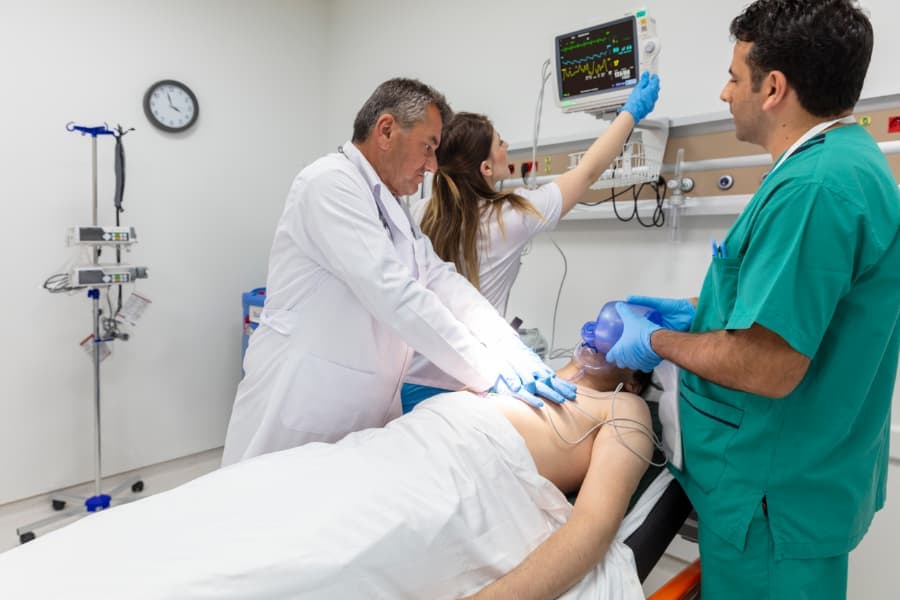A cardiac emergency is a sudden and serious medical situation for a patient and their loved ones. Heart rhythm issues, impacted arteries, and other underlying health problems can cause a cardiac emergency. Immediate treatment through emergency cardiac care is crucial for the best possible outcome. Here, we explore the different cardiac emergencies and the care provided to treat them.
Heart Attack
A heart attack occurs when blood flow to the heart sharply declines or becomes blocked. Plaque built up within heart arteries often causes this flow disruption. With blood supply disrupted, the heart muscle starts to die. Following a heart attack, various treatment options work to restore blood flow and repair damaged areas. Common heart attack treatment procedures include:
- Angioplasty: Physicians use a tube to open an impacted artery. Some tubes may include a balloon that pushes the plaque against the artery as it inflates.
- Atherectomy: This is a variation of angioplasty in which a tube is equipped with a blade or laser to cut or destroy plaque.
- Stent procedure: Physicians may also insert a structure (called a stent) to keep the artery open during an angioplasty.
- Bypass surgery: During this procedure, a surgeon takes a blood vessel in the body and attaches one end to the aorta and the other end below the impacted heart artery. This creates a new blood flow pathway. A patient may receive multiple new blood flow pathways if there are multiple impacted heart arteries.
- Heart valve surgery: Physicians perform this procedure to replace impacted heart valves. Typically, they repair the aortic valve or the mitral valve.
- Minimally invasive heart surgery: A physician makes incisions between the ribs to treat the heart with small machines or tools. This alternative to open-heart surgery has a faster recovery time.
- Transmyocardial revascularization (TMR): Physicians use a laser through the heart muscle into the heart’s lower left chamber to restore blood and oxygen flow.
To determine the damage caused by a heart attack, physicians consider the size of the area the impacted artery gave blood to, as well as how quickly treatment begins.
Cardiac Arrest
Cardiac arrest occurs when the heart suddenly stops beating due to a disruption to its electrical system. This causes an irregular heartbeat, called an arrhythmia, and keeps the heart from pumping blood to the rest of the body.
When someone experiences a cardiac emergency, they should head to the hospital immediately. Once there, immediate care will focus on improving the patient’s oxygen level and protecting their body. Emergency cardiac arrest treatment within a hospital may include:
- Extracorporeal membrane oxygenation: A heart-lung machine receives blood from the body, filters out carbon dioxide, and returns blood enriched with oxygen to the body.
- Oxygen therapy: Oxygen supplements administered to a patient help the organs resume their normal functions following the blood flow disruption during cardiac arrest.
- Targeted temperature management: Physicians apply cold blankets, helmets, packs, or other items to a patient to lower their body temperature.
Aortic Dissection
This cardiac emergency occurs when the inner layer of the aorta, the body’s main artery, tears. Blood passing through the tissue layers can cut off blood flow to other body parts or cause the aorta to burst.
The most common and severe of the two types of aortic dissection is Type A aortic dissection, which originates in the upper aorta near the heart. Physicians often treat these patients through surgery to remove what they can of the impacted aorta and keep blood from reaching the aortic wall. During surgery, surgeons rebuild the aorta with a tube called a graft. They also might replace the aortic valve if the impacted aorta caused it to leak. Medication to treat aortic dissection lowers blood pressure and heart rate.
A Type B aortic dissection develops further away from the heart in the lower part of the aorta. Depending on where the dissection developed and whether blood can flow to the body’s organs, physicians will determine if a patient requires immediate surgery.
Tachycardia
Tachycardia refers to an irregular heart rhythm in which a patient’s heart rate is over 100 beats per minute while at rest. This condition may come from either of the heart’s chambers. The vagal nerve helps to regulate heart rate. Vagal maneuvers, such as applying abdominal pressure, coughing, or a gag reflex, can help calm electricity within the heart. If these do not work, a physician may turn to one of these options:
- Ablation: Physicians run a tube to the heart where it applies a cold or hot energy blast to create scar tissue, which helps block unusual electric signals that cause arrhythmias.
- Cardioversion: Physicians use a machine to jolt the heart to its normal rhythm. Patients can also receive cardioversion through medication.
- Left atrial appendage closure: During this procedure, physicians close off or take out an area of the muscle wall in the heart’s top left chamber.
Physicians may also recommend that a patient receive a device, such as an implantable cardiac defibrillator or a peacemaker, to help restore proper heart rhythm.
Trust Richmond University Medical Center with Emergency Cardiac Care
Any cardiac emergency requires fast, comprehensive treatment. The award-winning professionals at Richmond University Medical Center on Staten Island, New York, are prepared to provide care for any cardiac health crisis. Contact us to schedule an appointment to learn more about different cardiac emergencies and how we manage emergency cardiac care.




